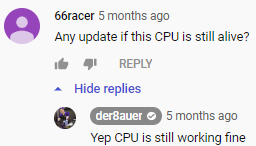Thermally Conductive, Electrically Insulating, Thin, Corrosion/Alloy/Permeability Resistant Conformal Coatings?
15 hours ago, Daharen said:Yep, that's what I was looking for, and I somewhat figured. I have seen people lap dies and put LM on it, but I've heard of no long term evaluations of this process to determine if it eventually does damage the CPU.
I am curious whether the LM will continue to bond indefinitely over time, and slowly alloy down to the circuitry if one waits long enough, or if its a process that naturally tends to dissipate the further from the source of the original substance the infiltration occurs, in which case eventually assuming you leave enough silicon on the chip, it will stop, and you'll have little to no risk of causing further damage.
It still seems to be working as of 5 months ago. https://www.youtube.com/watch?v=tnd2LO0IBic

I'm guessing you'd replace the cpu before it becomes an actual problem. It would depend on how much of the original coating is present.
















Create an account or sign in to comment
You need to be a member in order to leave a comment
Create an account
Sign up for a new account in our community. It's easy!
Register a new accountSign in
Already have an account? Sign in here.
Sign In Now